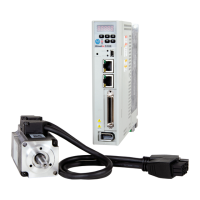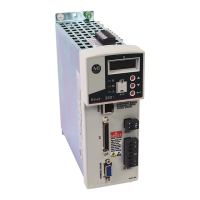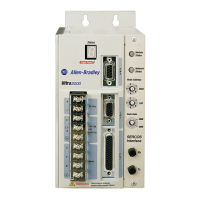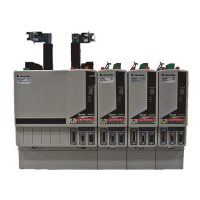228 Rockwell Automation Publication 2198-UM004A-EN-P - October 2019
Chapter 10 Modes of Operation
Sz and Tz dual mode are not provided. To avoid using too many digital inputs in a
dual mode, speed and torque (S-T) mode can apply external analog voltage as the
command source so as to reduce the use of DI points (SPD0, SPD1 or TCM0,
and TCM1). In addition, position mode can use pulse input to help reduce the
use of DI points (POS0…POS6).
Speed/Position Dual Mode
There are PT-S and PR-S in speed/position dual mode. The command source of
PT-S comes from external pulse while PR-S comes from internal parameters
ID397…ID524 (P6.000…P7.027). The Speed command can be issued by
external analog voltage or internal parameters ID125…ID127 (P1.009…P1.011,
internal speed commands 1…3). The switch of speed/position mode is controlled
by the DI.S-P (0x18) signal; switch of PT and PR for position mode is controlled
by the DI.PT-PR (0x2B) signal. Thus, both position and speed commands in PR-
S mode are selected by DI signal. The timing diagram is as follows.
In Speed mode (the DI.S-P signal is on), the speed command is selected via the
DI.SPD0 and DI.SPD1 signals. The DI.CTRG signal is not working at the
moment. When switching to Position mode (DI.S-P signal is off ), since position
command has not been issued (needs to wait for the rising edge of the DI.CTRG
signal), the motor stops. The position command is determined by the
DI.POS0…DI.POS6 signals, and triggered by the rising edge of the DI.CTRG
signal. When the DI.S-P signal is on, it resumes to the Speed mode.
Mode Short Name Setting Code Description
Dual
PT-S 06 PT and S can be switched by using the DI signal, S_P.
PT-T 07 PT and T can be switched by using the DI signal, T_P.
PR-S 08 PR and S can be switched by using the DI signal, S_P.
PR-T 09 PR and T can be switched by using the DI signal, T_P.
S-T 0A S and T can be switched by using the DI signal, S_T.
PT-PR 0D PT and PR can be switched by using the DI signal, PT_PR.
Multi-mode
(1)
(1) Multiple (multi-) modes are a combination of a dual mode and a single mode.
PT-PR-S 0E
PT, PR, and S can be switched by using the DI signal, S_P and
PT_PR.
PT-PR-T 0F
PT, PR, and T can be switched by using the DI signal, T_P and
PT_PR.

